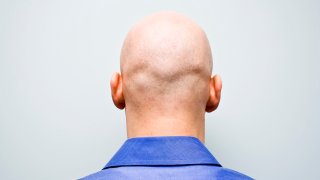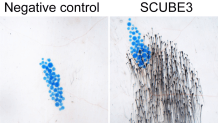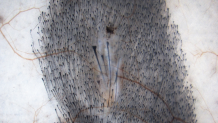
A U.K. employment tribunal argued that the use of the word “bald” as an insult related to a “protected characteristic of sex.”
Researchers at UC Irvine have made a new discovery that could be a game-changer for people losing their hair -- and it all comes down to one molecule.
According to a recent study published in Developmental Cell, a scientific journal focused on developmental and cellular biology, researchers at the California university have discovered a molecule that signals hair follicles to grow hair.
They also believe the discovery of that molecule may lead to powerful new treatments for hair loss.
How Does Hair Growth Work?
Get top local stories in Southern California delivered to you every morning. Sign up for NBC LA's News Headlines newsletter.
According to Maksim Plikus, UCI professor of developmental and cell biology and one of the authors of the study, the molecule he and his team discovered is significant because of the way hair follicles function in humans.
Human hair follicles work kind of like a 3D printer, Plikus explained in a phone call.
"In a printer, you have ink in the cartridge of some form. In a hair [follicle], it would be stem cells. That would be a biological ink."
Much like a 3D printer uses the plastic "ink" to create long strings of plastic, the hair follicle uses stem cells to create individual hairs.
But the hair follicle doesn't decide to start growing hair on its own, just like a 3D printer doesn't spontaneously start printing out plastic shapes.

The printer needs a computer to tell it when to start and what to print, and for hair follicles, Plikus said, the "computer cells" are specialized fibroblasts -- a kind of cell that helps create tissues -- called dermal papilla.
"They contain the molecular program" that controls how hair grows, Plikus said, as well as what the hair looks like. Curly or straight; thick or thin; blonde, red, brown or black, and growing or not -- that information is all determined by the dermal papilla cells that exist at the bottom of each hair follicle.
Until now, it wasn't quite known what prompted those dermal papilla to start growing hair, or why they stop.
"When it works, it works well, and when it doesn’t then it doesn’t," Plikus said.
In human hair follicles, the hair strand falls out fairly quickly after the follicle stops "printing," so for hair to stay as thick and beautiful as it typically is in young people, the follicles need to be constantly growing new hair.
"Think of a mega factory of 3D printers – all of them need to work, or else there will be not enough supply," Plikus explained. When there's not enough supply, hair is sparser and changes in texture, leading to hair loss.
Why Does This New Molecule Matter?
According to the UCI study, that hair loss occurs when the dermal papilla "computer cells" stop producing SCUBE3 -- the new signaling molecule the researchers discovered.
That signaling molecule tells the hair stem cells in nearby hair follicles to divide, which is what grows hair. If there's a lot of SCUBE3 present, nearby hair follicles will grow a lot of hair.
Conversely, if there's not enough of the signaling molecule around, hair follicles stay dormant, and dormant hair follicles means hair that falls out and doesn't grow back.
The molecule acted "as a potent hair growth trigger" in their experiments with hair growth in mice, Plikus said.
How Do They Know That Molecule is What Grows Hair?
The experiment Plikus and his team performed began with genetic tweaks to the hair follicles in mice.
Mouse hair follicles are a little different than those in humans. Where human hairs fall out if the hair follicles stop growing the strands, mice "glue strands in the hair follicle," Plikus explained.
In other words, the mice stay furry, but the hair follicles themselves aren't usually active.
The genetic tweak the UCI researchers made to the mice they were studying "put this mouse’s hairs into overdrive," Plikus said. Whatever change the researchers made to the mouse's "CPU cells" that controlled the hair's growth made the hair grow excessively.

That made their next question very clear -- what molecules did they inadvertently alter with the genetic change?
The SCUBE3 signaling molecule, which according to Plikus was "previously unknown to play a role" in the hair growth process, came out "bright and flashing" as a possible cause of the hair growth in their experiment.
So the researchers took that molecule, which they suspected was involved, and applied it directly near normal mouse hair follicles with a precise injection. Those injections -- which they tested repeatedly -- induced hair growth in the mice.
Other molecules, which researchers initially suspected may be involved with hair growth, didn't have as much of an effect.
The hair growth was especially notable because it happened so soon after the injections, and worked for human hair follicles.
The researchers transplanted human hair follicles into a mouse, and then injected the SCUBE3 molecule near those follicles.
Typically, transplanted human hair follicles take months to begin growing hair, Plikus explained. Moving the follicles is traumatizing to the cells, and the "hair is like, protesting, it shuts down," and goes dormant.
Eventually, slowly, they reactivate and begin growing again, which is why hair transplants work at all. But it can take up to six months -- much longer than the one month the human hair follicles in the mice injected with SCUBE3 took to begin growing in the experiment.

The mouse's human hair follicles also kept growing new hair without continual re-application of SCUBE3, which is a notable difference from the current hair-loss treatments that require taking a daily pill or daily application of lotion.
"[It's] pretty exciting," Plikus said.
What Does This Mean for Hair Loss Treatments?
More experiments are necessary before the UCI study's discovery can be applied and put toward new treatments for hair loss, Plikus said. But he's hopeful that SCUBE3 could lead people with all different kinds of alopecia -- baldness -- to grow new hair.
For mulltiple kinds of baldness, the hair follicles are fine, but inactive.
"No matter what’s caused the hair loss, when it’s happened, [the follicles are] there, they’re intact," Plikus said. One of the exceptions is scarring alopecia, which is caused by an autoimmune disease that actually injures and destroys hair follicles.
For other kinds of hair loss, ranging from androgenetic alopecia -- the testosterone-induced hair loss that occurs in mostly men, but also women as they age -- to chemotherapy and COVID-related hair loss, treatments involving the direct application of SCUBE3 could help.
"We would be very happy if it works on androgenetic alopecia," Plikus said.
"These experiments provide proof-of-principle data that SCUBE3 or derived molecules can be a promising therapeutic for hair loss," said co-first author Christian Guerrero-Juarez, a UCI postdoctoral researcher in mathematics, in the school's release about the experiment.
The next steps the researchers hope to take start with moving into a Phase 1 clinical trial with the FDA, Plikus said. That means large-scale animal safety experiments that hope will prove SCUBE3 will help grow new hair effectively, without causing any bad side-effects.
"We do believe chances are pretty good, because this is a naturally occurring molecule," Plikus said, with small amounts that would only be injected into the scalp skin.
If that phase of trials goes well, they might move on to human trials.
The research might also lead to stronger, synthetic molecules inspired by the naturally-produced SCUBE3 signaling molecule.
Plikus has helped co-found a biotechnology company with the purpose of moving this research into those trials, and UCI has filed a provisional patent application on the use of SCUBE3 and its related molecular compounds for hair growth stimulation.




